List of presidents of the Philippines
 |
|---|
|
|

Under the Constitution of the Philippines, the president of the Philippines (Filipino: Pangulo ng Pilipinas) is both the head of state and government, and serves as the commander-in-chief of the country's armed forces.[3][4] The president is directly elected by qualified voters to a six-year term and must be "a natural-born citizen of the Philippines, a registered voter, able to read and write, at least forty years of age on the day of the election, and a resident of the Philippines for at least ten years immediately preceding such election". No elected president can seek re-election. Upon resignation, or removal from the office, the vice president assumes the post. A president's successor who hasn't served for more than four years can still seek a full term for the presidency.[5]
History
[edit]Emilio Aguinaldo became the inaugural president of the Philippines under the Malolos Republic, considered the First Philippine Republic.[6][note 2] He held that office until 1901 when he was captured by United States forces during the Philippine–American War (1899–1902).[3] The American colonization of the Philippines abolished the First Republic,[11] which led to an American governor-general exercising executive power.[18]
In 1935, the United States, pursuant to its promise of full Philippine sovereignty,[19] established the Commonwealth of the Philippines following the ratification of the 1935 Constitution, which also restored the presidency. The first national presidential election was held,[note 3] and Manuel L. Quezon (1935–44) was elected to a six-year term, with no provision for re-election,[4] as the second Philippine president and the first Commonwealth president.[note 2] In 1940, however, the Constitution was amended to allow re-election but shortened the term to four years.[3] A change in government occurred three years later when the Second Philippine Republic was organized with the enactment of the 1943 Constitution, which Japan imposed after it occupied the Philippines in 1942 during World War II.[22] José P. Laurel acted as puppet president of the new Japanese-sponsored government;[23] his de facto presidency,[24] not legally recognized until the 1960s,[10] overlapped with that of the president of the Commonwealth, which went into exile. The Second Republic was dissolved after Japan surrendered to the Allies in 1945; the Commonwealth was restored in the Philippines in the same year with Sergio Osmeña (1944–46) as president.[3]
Manuel Roxas (1946–1948) followed Osmeña when he won the first post-war election in 1946. He became the first president of the independent Philippines when the Commonwealth ended on July 4 of that year. The Third Republic was ushered in and would cover the administrations of the next five presidents, the last of which was Ferdinand Marcos (1965–86),[3] who performed a self-coup by imposing martial law in 1972.[25] The dictatorship of Marcos saw the birth of the New Society (Filipino: Bagong Lipunan) and the Fourth Republic. His tenure lasted until 1986 when he was deposed in the People Power Revolution. The current constitution came into effect in 1987, marking the beginning of the Fifth Republic.[3]
Of the individuals elected as president, three died in office: two of natural causes (Manuel L. Quezon[26] and Manuel Roxas[27]) and one in a plane crash (Ramon Magsaysay, 1953–57[28]). The longest-serving president is Ferdinand Marcos with 20 years and 57 days in office; he is the only president to have served more than two terms. The shortest is Sergio Osmeña, who spent 1 year and 300 days in office.
Two women have held the office: Corazon Aquino (1986–92), who ascended to the presidency upon the successful People Power Revolution of 1986, and Gloria Macapagal Arroyo (2001–10), who, as vice president, ascended to the presidency upon Estrada's resignation and was elected to a full six-year term in 2004.
Presidents
[edit]| No. | Portrait | Name (Lifespan) |
Party | Term | Election | Vice president | Era | |
|---|---|---|---|---|---|---|---|---|
| 1 | 
|
Emilio Aguinaldo (1869–1964) |
None | January 23, 1899 – April 19, 1901[a] (2 years, 86 days) |
1899[b] | None[c] | First Republic | |
| None[d] | –[e] | None | U.S. Military Government | |||||
| –[f] | U.S. Insular Government | |||||||
| 2 | 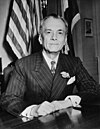
|
Manuel L. Quezon (1878–1944) |
Nacionalista | November 15, 1935 – August 1, 1944[g] (8 years, 260 days) |
1935 | Sergio Osmeña | Commonwealth | |
| 1941 | ||||||||
| 3 | 
|
Jose P. Laurel (1891–1959) |
KALIBAPI | October 14, 1943 – August 17, 1945[h] (1 year, 307 days) |
1943[i] | None[j] | Second Republic | |
| 4 | 
|
Sergio Osmeña (1878–1961) |
Nacionalista | August 1, 1944 – May 28, 1946 (1 year, 300 days) |
1941 | Vacant[k] | Commonwealth | |
| 5 | 
|
Manuel Roxas (1892–1948) |
Liberal | May 28, 1946 – April 15, 1948[g] (1 year, 323 days) |
1946 | Elpidio Quirino | ||
| Third Republic | ||||||||
| 6 | 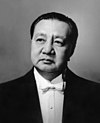
|
Elpidio Quirino (1890–1956) |
Liberal | April 17, 1948 – December 30, 1953 (5 years, 257 days) |
Vacant[k] | |||
| 1949 | Fernando Lopez[l] | |||||||
| 7 | 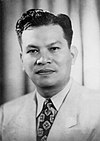
|
Ramon Magsaysay (1907–1957) |
Nacionalista | December 30, 1953 – March 17, 1957[g] (3 years, 77 days) |
1953 | Carlos P. Garcia | ||
| 8 | 
|
Carlos P. Garcia (1896–1971) |
Nacionalista | March 18, 1957 – December 30, 1961 (4 years, 287 days) |
None[k] | |||
| 1957 | Diosdado Macapagal[m] | |||||||
| 9 | 
|
Diosdado Macapagal (1910–1997) |
Liberal | December 30, 1961 – December 30, 1965 (4 years) |
1961 | Emmanuel Pelaez[n] | ||
| 10 | 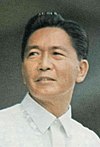
|
Ferdinand Marcos (1917–1989) |
Nacionalista (until 1978) |
December 30, 1965 – February 25, 1986[o] (20 years, 57 days) |
1965 | Fernando Lopez | ||
| 1969 | ||||||||
| Martial Law | ||||||||
| None[p] | ||||||||
| 1973[q] | ||||||||
| 1977[q] | ||||||||
| KBL (from 1978) | ||||||||
| 1981 | Fourth Republic | |||||||
| Vacant[r] | ||||||||
| 11 | 
|
Corazon Aquino (1933–2009) |
UNIDO (until 1988) |
February 25, 1986 – June 30, 1992 (6 years, 126 days) |
1986[s] | Salvador Laurel[t] | Provisional Government | |
| Fifth Republic | ||||||||
| Independent (from 1988) | ||||||||
| 12 | 
|
Fidel V. Ramos (1928–2022) |
Lakas–NUCD | June 30, 1992 – June 30, 1998 (6 years) |
1992 | Joseph Estrada[u] | ||
| 13 | 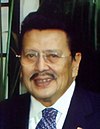
|
Joseph Estrada (born 1937) |
LAMMP | June 30, 1998 – January 20, 2001[v] (2 years, 204 days) |
1998 | Gloria Macapagal Arroyo[w] | ||
| 14 | 
|
Gloria Macapagal Arroyo (born 1947) |
Lakas–CMD | January 20, 2001 – June 30, 2010 (9 years, 161 days) |
Vacant[x] | |||
| Teofisto Guingona Jr.[y] | ||||||||
| 2004 | Noli de Castro[z] | |||||||
| 15 | 
|
Benigno Aquino III (1960–2021) |
Liberal | June 30, 2010 – June 30, 2016 (6 years) |
2010 | Jejomar Binay[aa] | ||
| 16 | 
|
Rodrigo Duterte (born 1945) |
PDP–Laban | June 30, 2016 – June 30, 2022 (6 years) |
2016 | Leni Robredo[m] | ||
| 17 | 
|
Bongbong Marcos (born 1957) |
PFP | June 30, 2022 – present (2 years, 120 days) |
2022 | Sara Duterte[ab] | ||
Timeline
[edit]
Unofficial presidents
[edit]Andrés Bonifacio is considered by some historians to be the first president of the Philippines. He was the third Supreme President (Spanish: Presidente Supremo; Tagalog: Kataastaasang Pangulo) of the Katipunan secret society. Its Supreme Council, led by the Supreme President, coordinated provincial and district councils. When the Katipunan went into open revolt in August 1896 (the Cry of Balintawak), Bonifacio transformed it into a revolutionary government with him as president. While the term Katipunan remained, Bonifacio's government was also known as the Tagalog Republic (Tagalog: Republika ng Katagalugan; Spanish: Republica Tagala). (Although the word Tagalog refers to a specific ethnicity, Bonifacio used it to denote all indigenous people in the Philippines in place of Filipino which had colonial origins.)[30][31][32][33][34]
Some historians contend that including Bonifacio as a past president would imply that Macario Sakay and Miguel Malvar y Carpio should also be included.[35] Miguel Malvar y Carpio continued Emilio Aguinaldo's leadership of the First Philippine Republic after the latter's capture until his own capture in 1902. Macario Sakay revived the Tagalog Republic in 1902 as a continuation of Bonifacio's Katipunan. They are both considered by some scholars as "unofficial presidents". Along with Bonifacio, Malvar and Sakay are not recognized as presidents by the Philippine government.[36][37]
Emilio Aguinaldo is officially recognized as the first president of the Philippines, but this is based on his term of office during the Malolos Republic, later known as the First Philippine Republic. Prior to this Aguinaldo had held the presidency of several revolutionary governments which are not counted in the succession of Philippine republics.
Manuel L. Quezon delegated his presidential duties to José Abad Santos, the then Chief Justice, when the former fled the Philippines amidst Japanese occupation of the islands to establish a government-in-exile. He is believed to have in effect become the acting president of the Philippine Commonwealth though no legal document has been retrieved detailing the official transfer of the title of President to Abad Santos.[38]
List
[edit]| Portrait | Name Lifespan |
Party | Term | Vice President | Government | ||
|---|---|---|---|---|---|---|---|
| Took office | Left office | ||||||
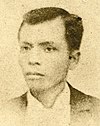
|
Andrés Bonifacio (1863–1897) [34][39][40][41] |
None | August 24, 1896[ac] | March 22, 1897[ad] or May 10, 1897[ae] |
None | Sovereign Tagalog Nation | |

|
Emilio Aguinaldo (1869–1964) |
None | March 22, 1897[af] | November 1, 1897[ag] | Mariano Trias | Tejeros revolutionary government | |
| November 2, 1897[ah] | December 14, 1897[ai] | Republic of Biak-na-Bato | |||||
| May 24, 1898 | June 23, 1898[aj] | Dictatorial Government | |||||
| June 23, 1898[ak][42] | January 23, 1899[al] | Revolutionary Government | |||||

|
Francisco Makabulos (1871–1922) |
None | April 17, 1898 | May 19, 1898[am] | None | Central Executive Committee | |
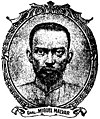
|
Miguel Malvar (1865–1911) [43] |
None | April 19, 1901[an] | April 16, 1902[ao] | None[ap] | First Republic | |

|
Macario Sakay (1870–1907) [44][45][46] |
Katipunan (holdout/revival) |
May 6, 1902[aq] | July 14, 1906[ar] | Francisco Carreón | Tagalog Republic | |

|
José Abad Santos (1886–1942) [38] |
Independent | March 17, 1942 | May 2, 1942 | None | Commonwealth | |

|
Jorge B. Vargas (1890–1980) |
KALIBAPI Association for Service to the New Philippines |
January 23, 1942 | October 14, 1943 | None | Philippine Executive Commission | |

|
Arturo Tolentino (1910–2004) [47][48] |
Kilusang Bagong Lipunan New Society Movement |
July 6, 1986[as] | July 8, 1986 | None | Fourth Republic | |
Timeline
[edit]
List of presidents by age
[edit]| No. | President | Born | Age at start of presidency | Age at end of presidency | Post-presidency timespan | Lifespan | |
|---|---|---|---|---|---|---|---|
| Died | Age | ||||||
| 1 | Emilio Aguinaldo | March 22, 1869 | 29 years, 10 months, 1 day January 23, 1899 |
32 years, 22 days March 23, 1901 |
62 years, 10 months, 14 days | February 6, 1964 | 94 years |
| 2 | Manuel Quezon | August 19, 1878 | 57 years, 2 months, 27 days February 15, 1935 |
65 years, 11 months, 13 days August 1, 1944 |
Died in office | August 1, 1944 | 65 years |
| 3 | Jose P. Laurel | March 9, 1891 | 52 years, 7 months, 5 days October 14, 1943 |
54 years, 5 months, 8 days August 17, 1945 |
14 years, 2 months, 20 days | November 6, 1959 | 68 years |
| 4 | Sergio Osmeña | September 9, 1878 | 65 years, 10 months, 23 days August 1, 1944 |
67 years, 8 months, 19 days May 28, 1946 |
15 years, 4 months, 21 days | October 19, 1961 | 83 years |
| 5 | Manuel Roxas | January 1, 1892 | 54 years, 4 months, 27 days May 28, 1946 |
56 years, 3 months, 14 days April 15, 1948 |
Died in office | April 15, 1948 | 56 years |
| 6 | Elpidio Quirino | November 16, 1890 | 57 years, 5 months, 1 day April 17, 1948 |
63 years, 1 month, 14 days December 30, 1953 |
2 years, 1 month, 30 days | February 29, 1956 | 65 years |
| 7 | Ramon Magsaysay | August 31, 1907 | 46 years, 3 months, 29 days December 30, 1953 |
49 years old, 6 months, 14 days March 17, 1957 |
Died in office | March 17, 1957 | 49 years |
| 8 | Carlos P. Garcia | November 4, 1896 | 60 years, 5 months, 14 days March 18, 1957 |
65 years, 1 months, 26 days December 30, 1961 |
9 years, 5 months, 15 days | June 14, 1971 | 74 years |
| 9 | Diosdado Macapagal | September 28, 1910 | 51 years, 3 months, 2 days December 30, 1961 |
55 years, 3 months, 2 days December 30, 1965 |
31 years, 3 months, 22 days | April 21, 1997 | 86 years |
| 10 | Ferdinand E. Marcos | September 11, 1917 | 48 years, 3 months, 19 days December 30, 1965 |
68 years, 5 months, 14 days February 25 1986 |
3 years, 7 months, 3 days | September 28, 1989 | 72 years |
| 11 | Corazon Aquino | January 25, 1933 | 53 years, 1 month February 25, 1986 |
59 years, 5 months, 5 days June 30, 1992 |
17 years, 1 months, 2 days | August 1, 2009 | 76 years |
| 12 | Fidel V. Ramos | March 18, 1928 | 64 years old, 3 months, 12 days June 30, 1992 |
70 years old, 3 months, 12 days June 30, 1998 |
24 years, 1 month, 1 day | July 31, 2022 | 94 years |
| 13 | Joseph Estrada | April 19, 1937 | 61 years, 2 months, 11 days June 30, 1998 |
63 years, 9 months, 1 day January 20, 2001 |
(Living) | (Living) | 87 years, 192 days |
| 14 | Gloria Macapagal Arroyo | April 5, 1947 | 53 years, 9 months, 15 days January 20, 2001 |
63 years, 2 months, 25 days June 30, 2010 |
(Living) | (Living) | 77 years, 206 days |
| 15 | Benigno Aquino III | February 8, 1960 | 50 years, 4 months, 22 days June 30, 2010 |
56 years, 4 months, 22 days June 30, 2016 |
4 years, 21 months, 25 days | June 24, 2021 | 61 years |
| 16 | Rodrigo Duterte | March 28, 1945 | 71 years, 3 months, 2 days June 30, 2016 |
77 years, 3 months, 2 days June 30, 2022 |
(Living) | (Living) | 79 years, 214 days |
| 17 | Bongbong Marcos | September 13, 1957 | 64 years, 9 months, 3 days June 30, 2022 |
(Incumbent) | (Incumbent) | (Living) | 67 years, 45 days |
List of presidents by offices held before presidency
[edit]Executive branch
[edit]Vice presidents
[edit]| Vice President | President served under | Year(s) served | Notes |
|---|---|---|---|
| Sergio Osmeña | Manuel L. Quezon | 1935–1944 | Osmeña succeeded Quezon, after the latter's death |
| Elpidio Quirino | Manuel Roxas | 1946–1948 | Quirino succeeded Roxas, after the latter's death; Ran and won a full term in 1949. |
| Carlos P. Garcia | Ramon Magsaysay | 1953–1957 | Garcia succeeded Magsaysay, after the latter's death; Ran and won a full term in 1957. |
| Diosdado Macapagal | Carlos P. Garcia | 1957–1961 | Macapagal defeated Garcia in 1961. |
| Joseph Estrada | Fidel V. Ramos | 1992–1998 | Estrada ran for a full term in 1998. |
| Gloria Macapagal Arroyo | Joseph Estrada | 1998–2001 | Arroyo succeeded Estrada, after the latter's resignation; Ran and won a full term in 2004 |
3 other former vice presidents (S. Laurel, Binay, and Robredo) all made failed runs for the presidency.
Cabinet secretaries
[edit]The following cabinet secretaries are only served for fulltime. Vice Presidents served as cabinet secretary concurrently are not included.
| Secretary | Office | President served under | Year(s) served |
|---|---|---|---|
| Elpidio Quirino | Secretary of Finance | Manuel Quezon | 1934– 1936 |
| Secretary of Interior | 1935–1938 | ||
| Manuel Roxas | Secretary of Interior | 1941 | |
| Ramon Magsaysay | Secretary of National Defense | Elpidio Quirino | 1935–1944 |
| Fidel V. Ramos | Corazon Aquino | 1988–1991 |
Other positions
[edit]| Name | Office | President served under | Year(s) served |
|---|---|---|---|
| Gloria Macapagal Arroyo | Undersecretary of the Department of Trade and Industry | Corazon Aquino | 1987–1992 |
Legislative
[edit]Senators
[edit]| Senator | District | Year(s) served | Notes |
|---|---|---|---|
| Manuel L. Quezon | 5th | 1916–1935 | First president to serve as Senate President (1916–1935) |
| Jose P. Laurel | 1925–1931 | Only former president to serve as senator (1951–1957);
Only senator served as Majority Floor Leader (1925–1931) | |
| Sergio Osmeña | 10th | 1922–1935 | First president served as President pro tempore (1922–1934) |
| Manuel Roxas | At-large | 1945–1946 | Second president served as Senate President (1916–1935) |
| Elpidio Quirino | 1st | 1925–1935 | Second and last president served as President pro tempore (1945–1946) |
| At-large | 1945–1946 | ||
| Carlos P. Garcia | 1945–1953 | First President served as Minority Floor Leader (1946–1953) | |
| Ferdinand E. Marcos | 1959–1965 | Second President served as Minority Floor Leader (1960–1962)
Third and last president served as Senate President (1963–1965) | |
| Joseph Estrada | 1987–1992 | ||
| Gloria Macapagal Arroyo | 1992–1998 | ||
| Benigno Aquino III | 2007–2010 | Did not finish term, won presidency | |
| Bongbong Marcos | 2010–2016 |
Congressman/Representatives/Assemblyman
[edit]| Legislator | District | Lower House Name | Year(s) served | Notes |
|---|---|---|---|---|
| Manuel L. Quezon | Tayabas 1st | Philippine Assembly | 1907–1909 | First president to serve as Majority Floor Leader (1907–1909) |
| Sergio Osmeña | Cebu 2nd | Philippine Assembly | 1907–1916 | First President to serve as speaker (1907–1916) |
| House of Representatives | 1916–1922 | |||
| Manuel Roxas | Capiz 1st | House of Representatives | 1922–1935 | Second president to serve as Majority Floor Leader;
Second president to serve as speaker (1922–1934) |
| National Assembly | 1935–1938 | |||
| Elpidio Quirino | Ilocos Sur 1st | House of Representatives | 1919–1925 | |
| Ramon Magsaysay | Zambales at-large | 1946–1950 | ||
| Carlos P. Garcia | Bohol 3rd | 1925–1931 | ||
| Diosdado Macapagal | Pampanga 1st | 1949–1957 | ||
| Ferdinand E. Marcos | Ilocos Norte 2nd | 1949–1959 | ||
| Benigno Aquino III | Tarlac 2nd | 1998–2007 | The only former Deputy Speaker (2004–2006) | |
| Rodrigo Duterte | Davao City 1st | 1998–2001 | ||
| Bongbong Marcos | Ilocos Norte 2nd | 1992–1995; 2007– 2010 |
Local government
[edit]Governors
[edit]| Governor | Province | Year(s) served | Notes |
|---|---|---|---|
| Manuel Quezon | Tayabas | 1906–1907 | |
| Sergio Osmeña | Cebu | 1904–1907 | |
| Manuel Roxas | Capiz | 1919–1922 | |
| Carlos P. Garcia | Bohol | 1933–1941 | |
| Bongbong Marcos | Ilocos Norte | 1983–1986; 1998–2007 | Only president formerly served as Vice Governor (1980–1983) |
Mayors
[edit]| Mayor | City/Municipality | Year(s) served | Notes |
|---|---|---|---|
| Joseph Estrada | San Juan | 1969–1986 | Only former president served as mayor (2013–2019) |
| Rodrigo Duterte | Davao City | 1988–1998; 2001–2010; 2013–2016 | Only president served as Vice Mayor (1986–1987; 2010–2013) |
Municipal/City Councilors
[edit]| Name | Municipality/City | Province | Year(s) served |
|---|---|---|---|
| Manuel Quezon | Lucena | Tayabas | 1906 |
| Manuel Roxas | Capiz | Capiz | 1917–1919 |
Judiciary
[edit]| Name | Position | Year(s) served | President | Notes |
|---|---|---|---|---|
| Jose P. Laurel | Associate Justice of the Supreme Court | 1936–1942 | Manuel Quezon | Only president served in the Supreme Court |
International Affairs-related
[edit]| Name | Office | President served under | Year(s) served |
|---|---|---|---|
| Manuel Quezon | Resident Commissioner of the Philippines | None (Under American rule) | 1909–1916 |
Presidents who had not previously held elective office
[edit]Without previous experience in government, but served in the military
[edit]| Name | Year(s) served |
|---|---|
| Emilio Aguinaldo | 1899–1901 |
Without previous experience in government or in the military
[edit]| Name | Year(s) served |
|---|---|
| Corazon Aquino | 1986–1992 |
List of presidents by military service
[edit]| Name | Rank | Branch | Year(s) served | Notes |
|---|---|---|---|---|
| Emilio Aguinaldo | Generalissimo | Philippine Revolutionary Army | 1896–1901 | |
| Manuel Quezon | Major | Philippine Revolutionary Army | 1899–1900 | |
| Manuel Roxas | Brigadier General | Philippine Commonwealth Army | 1941–1945 | |
| Ramon Magsaysay | Captain | Philippine Commonwealth Army | 1942–1945 | |
| Ferdinand E. Marcos | 1st Lieutenant | USAFFE | 1942–1945 | |
| Major | USAFIP-NL | |||
| Fidel V. Ramos | General | Philippine Constabulary | 1950–1988 | Only former President served as Chief of Staff of the Armed Forces (1984–1985; 1986–1988), and commander of a service branch (1972–1986). |
Notes
[edit]- ^ The president has three official residences, with the Malacañang Palace Complex as the principal abode and workplace.[1] The others are Mansion House in Baguio, the official summer residence,[2] and Malacañang of the South, the official residence in Davao City.
- ^ a b In chronological order, the presidents started with Manuel L. Quezon,[7] who was then succeeded by Sergio Osmeña as the second president,[8] until the recognition of Emilio Aguinaldo[9] and José P. Laurel's[10] presidencies in the 1960s.[subnote 1][subnote 2] With Aguinaldo as the first president and Laurel as the third, Quezon and Osmeña are thus listed as the second and the fourth, respectively.[3][17]
- ^ Emilio Aguinaldo, the official first president, was elected by the Malolos Congress and not by popular vote.[20][21]
Subnotes
- ^ The Malolos Republic, an independent revolutionary state that is actually the first constitutional republic in Asia,[11][12] remained unrecognized by any country[13][14] until the Philippines acknowledged the government as its predecessor,[15] which it also calls the First Philippine Republic.[11][9][16] Aguinaldo was consequently counted as the country's first president.[6][9]
- ^ The Second Republic was later declared by the Supreme Court of the Philippines as a de facto, illegitimate government on September 17, 1945.[10] Its laws were considered null and void;[3][10] despite this, Laurel was included in the official roster of Philippine presidents in the 1960s.[10]
Other notes
- ^ Date in which Aguinaldo formally swore allegiance to the United States and published a manifesto to the Philippine people to lay down their weapons after being captured by American forces in Palanan, Isabela in March 23 of the same year.
- ^ Elected by the Malolos Congress.
- ^ The 1899 Constitution did not provide for a vice president.
- ^ Executive authority was held by American military governors from August 14, 1898 until July 1, 1902 and by American governors-general from July 4, 1901 until November 15, 1935.
- ^ American military governors were appointed by the president of the United States exercising his powers as commander-in-chief.
- ^ American governors-general were appointed by the president of the United States, with advice and consent of the United States Senate.
- ^ a b c Died in office.
- ^ Japanese-sponsored Second Republic dissolved following the surrender of Japan in World War II.
- ^ Elected by the National Assembly.
- ^ The 1943 Constitution did not provide for a vice president.
- ^ a b c Under the 1935 Constitution, a vacancy in the vice presidency could not be filled.
- ^ Left the Liberal Party to become a member of the Democratic Party in 1953.
- ^ a b Affiliated with the Liberal Party.
- ^ Left the Liberal Party to become a member of the Nacionalista Party in 1964.
- ^ Removed from office and went into exile following the People Power Revolution.
- ^ The 1973 Constitution abolished the vice presidency.
- ^ a b Ferdinand Marcos' term as president extended through a referendum.
- ^ The 1973 Constitution was amended in 1984 to restore the vice presidency, but an election was not called until 1986.
- ^ In the 1986 presidential election, Ferdinand Marcos was declared the winner by the Batasang Pambansa and the Commission on Elections, while Corazon Aquino was declared the winner by the National Citizens' Movement for Free Elections. The fraudulent conduct and disputed result of the election led to the People Power Revolution.
- ^ Affiliated with both UNIDO and the Nacionalista Party at election; left UNIDO in 1988.
- ^ Affiliated with the Nationalist People's Coalition at election; founded Laban ng Makabayang Masang Pilipino in 1997.
- ^ Resigned from office following the Second EDSA Revolution, with the Supreme Court confirming the constitutionality of his resignation on March 2, 2001.[29]
- ^ Affiliated with Lakas–NUCD.
- ^ From January 20 until February 7, 2001.
- ^ Appointed as vice president on February 7, 2001. Resigned from Lakas-NUCD on October 3, 2003.
- ^ Not affiliated to a political party.
- ^ Affiliated with PDP–Laban at election; founded the United Nationalist Alliance in 2012.
- ^ Affiliated with both Lakas–CMD and Hugpong ng Pagbabago at election; resigned from Lakas–CMD on May 19, 2023.
- ^ Term began when Bonifacio declared the establishment of the Tagalog Republic.
- ^ Term ended after the Tejeros Convention.
- ^ Executed for treason by Aguinaldo's government; Bonifacio did not recognize its validity and still acted as president.
- ^ Term was established at the Tejeros Convention; Aguinaldo took his oath of office the day after (March 23), but did not fully assume the office until late April 1897.
- ^ Term ended with the establishment of the Republic of Biak-na-Bato.
- ^ Term began after the establishment of the Republic of Biak-na-Bato.
- ^ Term ended when Aguinaldo signed the Pact of Biak-na-Bato.
- ^ Term ended when Aguinaldo shifted from dictatorial to revolutionary government.
- ^ Term began with the [http://www.pangulo.ph/prexy_efa.php declaration of a revolutionary government replacing the dictatorship.
- ^ Term ended with the inauguration of the First Philippine Republic.
- ^ Term ended upon the return of Aguinaldo, who established a dictatorship.
- ^ Term began when Malvar presumptively assumed the presidency after the declaration of Aguinaldo to the United States.
- ^ Term ended when Malvar surrendered in Batangas.
- ^ The constitution at this time did not create an office of the vice president.
- ^ Term began when Sakay declared the establishment of the Tagalog Republic (in the tradition of Bonifacio instead of Aguinaldo).
- ^ Term ended when Sakay surrendered as part of an amnesty; he was executed a year later.
- ^ The running-mate of former President Ferdinand Marcos in the February 1986 presidential election. Proclaimed himself as acting president in a coup attempt.
See also
[edit]References
[edit]- ^ Ortiguero, Romsanne (October 22, 2014). "TRAVEL Inside Malacañang Complex, 3 places to visit for a charming date with history". News5. TV5. Archived from the original on June 30, 2016. Retrieved June 22, 2016.
- ^ "Mansion House". Presidential Museum and Library. Presidential Communications Development and Strategic Planning Office. Retrieved June 20, 2016.
- ^ a b c d e f g h "The Executive Branch". Official Gazette. Presidential Communications Development and Strategic Planning Office. Retrieved June 18, 2016.
- ^ a b PCDSPO 2015, pp. 62–64
- ^ "The Constitution of the Republic of the Philippines". Official Gazette. Presidential Communications Development and Strategic Planning Office 3208.
- ^ a b Tucker 2009, p. 8
- ^ Quezon, Manuel Luis M. (December 30, 1941). "Second Inaugural Address of President Quezon". Official Gazette. Presidential Communications Development and Strategic Planning Office. Retrieved July 22, 2016.
- ^ Staff writer(s) (October 19, 1961). "Sergio Osmena, Second President of the Philippines". Toledo Blade. Manila: Block Communications. Retrieved July 22, 2016.
- ^ a b c Pascual, Federico D. Jr. (September 26, 2010). "Macapagal legacy casts shadow on today's issues". The Philippine Star. Retrieved July 22, 2016.
- ^ a b c d e Staff writer(s) (October 14, 2015). "Second Philippine Republic". Presidential Museum and Library. Presidential Communications Development and Strategic Planning Office. Archived from the original on March 15, 2015. Retrieved July 6, 2016.
- ^ a b c Staff writer(s) (September 7, 2012). "The First Philippine Republic". National Historical Commission of the Philippines. Retrieved June 17, 2016.
- ^ "Araw ng Republikang Filipino, 1899" [Philippine Republic Day, 1899]. Official Gazette. Presidential Communications Development and Strategic Planning Office. Retrieved June 22, 2016.
- ^ Tucker 2009, p. 496
- ^ Abueva, José V. (February 12, 2013). "Our only republic". Philippine Daily Inquirer. Retrieved June 22, 2016.
- ^ Macapagal, Diosdado (June 12, 1962). "Address of President Macapagal on Independence Day". Official Gazette. Presidential Communications Development and Strategic Planning Office. Archived from the original on April 16, 2016.
- ^ "Proclamation No. 533, s. 2013". Official Gazette. Presidential Communications Development and Strategic Planning Office. January 9, 2013. Retrieved July 25, 2016.
- ^ "Philippine Presidents". Presidential Museum and Library. Presidential Communications Development and Strategic Planning Office. Archived from the original on May 27, 2016. Retrieved June 15, 2016.
- ^ Agoncillo & Guerrero 1970, p. 281
- ^ "The Commonwealth of the Philippines". Official Gazette. Presidential Communications Development and Strategic Planning Office. Retrieved July 8, 2016.
- ^ "Emilio Aguinaldo". Presidential Museum and Library. Presidential Communications Development and Strategic Planning Office. Archived from the original on November 4, 2012. Retrieved June 15, 2016.
- ^ PCDSPO 2015, p. 203
- ^ Jose, Ricardo T. (1997). Afterword. His Excellency Jose P. Laurel, President of the Second Philippine Republic: Speeches, Messages and Statements, October 14, 1943 to December 19, 1944. By Laurel, José P. Manila: Lyceum of the Philippines in cooperation with the José P. Laurel Memorial Foundation. ISBN 971-91847-2-8. Retrieved June 18, 2016 – via Presidential Museum and Library.
- ^ Staff writer(s) (September 3, 1945). "The Philippines: End of a Puppet". Time. Retrieved July 5, 2016.
- ^ "Today is the birth anniversary of President Jose P. Laurel". Presidential Museum and Library. Presidential Communications Development and Strategic Planning Office. Retrieved June 18, 2016.
- ^ "Declaration of Martial Law". Official Gazette. Presidential Communications Development and Strategic Planning Office. Retrieved June 18, 2016.
- ^ Tejero, Constantino C. (November 8, 2015). "The real Manuel Luis Quezon, beyond the posture and bravura". Philippine Daily Inquirer. Retrieved June 16, 2016.
- ^ Staff writer(s) (April 16, 1948). "Heart Attack Fatal to Philippine Pres. Roxas". Schenectady Gazette. Manila. Retrieved June 16, 2016.
- ^ "Death Anniversary of President Ramon Magsaysay". Presidential Museum and Library. Presidential Communications Development and Strategic Planning Office. March 17, 2013. Retrieved June 16, 2016.
- ^ Panganiban, Artemio V. (January 17, 2016). "Constitutionality of Edsa 1 and Edsa 2". Inquirer. Retrieved February 27, 2022.
- ^ Borromeo-Buehler & Borromeo 1998, pp. M1 25 (Item 3 in the list, referring to Note 41 at p.61, citing Guerrero, Encarnación & Villegas 1996); ^ Borromeo-Buehler & Borromeo 1998, pp. 26, "Formation of a revolutionary government"; ^ Borromeo-Buehler & Borromeo 1998, pp. M1 135 (in "Document G", Account of Mr. Bricco Brigado Pantos).
- ^ Halili & Halili 2004, pp. 138–139.
- ^ Severino, Howie (November 27, 2007), Bonifacio for (first) president, GMA News.
- ^ Guerrero, Milagros; Schumacher, S.J., John (1998), Reform and Revolution, Kasaysayan: The History of the Filipino People, vol. 5, Asia Publishing Company Limited, ISBN 962-258-228-1.
- ^ a b Guerrero, Milagros; Encarnación, Emmanuel; Villegas, Ramón (1996), "Andrés Bonifacio and the 1896 Revolution", Sulyap Kultura, 1 (2), National Commission for Culture and the Arts: 3–12, archived from the original on November 15, 2010.
- ^ Ambeth Ocampo (May 11, 2010). "Bonifacio, First President of the Philippines?". Philippine Daily Inquirer.
- ^ manilatimes.net, Lawmaker: History wrong on Gen. Malvar Archived 2008-01-04 at the Wayback Machine
- ^ Flores, Paul (August 12, 1995), Macario Sakay: Tulisán or Patriot?, Philippine History Group of Los Ángeles, archived from the original on June 9, 2007, retrieved April 8, 2007
- ^ a b Orejas, Tonette (February 22, 2017). "Abad Santos, acting Commonwealth president, gets proper honors in place where he died". newsinfo.inquirer.net.
- ^ Guererro, Francis Rodney; Songalia (1998). Reform and Revolution. Kasaysayan: The History of the Filipino People. Vol. 5. Asia Publishing Company Limited. ISBN 962-258-228-1.
- ^ Borromeo-Buehler, Soledad; Borromeo, Soledad Masangkay (1998). The Cry of Balintawak: a contrived controversy. Quezon City: Ateneo de Manila University Press. ISBN 971-550-278-4.
- ^ Severino, Howie (November 27, 2007). "Bonifacio for (first) president". gmanews.tv. GMA Network. Retrieved August 20, 2009.
- ^ "Emilio Aguinaldo y Famy". pangulo.ph. Archived from the original on December 5, 2004.
- ^ Cruz, Maricel V. (February 2, 2008). "Lawmaker: History wrong on Gen. Malvar". www.manilatimes.net. Manila Times. Archived from the original on December 11, 2008. Retrieved August 20, 2009.
- ^ Agoncillo, Teodoro (1990) [1960]. History of the Filipino People (8th ed.). Quezon City: Garotech Publishing Inc. ISBN 971-10-2415-2.
- ^ Flores, Paul (August 12, 1995). "Macario Sakay: Tulisán or Patriot?". Philippine History Group of Los Angeles. Archived from the original on June 9, 2007. Retrieved April 8, 2007.
- ^ Tan, Michael (September 21, 2007). "September's heroes". www.inquirer.net. Philippine Daily Inquirer. Retrieved August 20, 2009.
- ^ Yabes, Criselda (July 7, 1986). "Marcos' Man Tolentino Declares Himself President". Associated Press News. Retrieved October 15, 2021.
- ^ "GMA, former Senate colleagues pay tribute to Arturo Tolentino, 94". The Philippine Star. August 4, 2004. Retrieved October 15, 2021.
Works cited
[edit]- Agoncillo, Teodoro A.; Guerrero, Milagros C. (1970). History of the Filipino People (3rd ed.). Malaya Books.
- Chandler, David Porter; Steinberg, David Joel (1987). In Search of Southeast Asia: A Modern History (Revised ed.). University of Hawaii Press. ISBN 0-8248-1110-0.
- Guevara, Sulpicio, ed. (2005) [1898]. The laws of the first Philippine Republic (the laws of Malolos) 1898–1899. Compiled, edited, and translated into English by Sulpicio Guevara. Manila: National Historical Institute (published 1972). ISBN 971-538-055-7 – via University of Michigan Library.
- Halili, Christine N; Halili, Maria Christine (2004), Philippine History, Rex Bookstore, ISBN 978-971-23-3934-9.
- Philippine Electoral Almanac (PDF) (Revised and expanded ed.). Manila: Presidential Communications Development and Strategic Planning Office. 2015. ISBN 978-971-95551-6-2 – via Internet Archive.
- Tucker, Spencer, ed. (2009). The Encyclopedia of the Spanish–American and Philippine–American Wars: A Political, Social, and Military History. Vol. 1 (Illustrated ed.). ABC-CLIO. ISBN 978-1-85109-951-1.
External links
[edit]- Presidential Website
- Office of the President of the Philippines
- Presidential Museum and Library
- Philippines at worldstatesmen.org+
